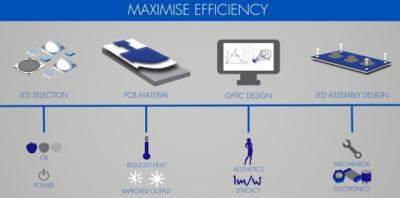
Outdoor amenity lighting is the perfect application to benefit from LED technology. From reducing maintenance costs and saving energy to reducing light losses and power consumption, LED is the ideal solution.
When designing your amenity lighting product – be it a car park light, floodlight, pathway light or any wide area illumination product – there are 4 factors to consider to achieve an outstanding solution.
First things first, LED device selection is critical to achieve the high lumen output necessary for exterior illumination. Colour Rendering Index (CRI) must be a consideration at this stage. CRI is the indicator for how well a light source performs at representing colours. In certain applications it is very important that a lamp achieves excellent colour rendition, particularly within the retail sector. CRI is often not so critical for exterior area illumination, so it is perfectly acceptable to opt for slightly lower CRI values. This allows you to achieve greater energy efficiency as higher CRILEDs lose efficiency due to working the blue light, initially created, within the LED into a wider range of wavelengths.
In order to achieve the high lumen output necessary for exterior illumination LED device selection also must review: high efficacy, high lumen density and high intensity LEDs, to get the best possible performance and light output. By selecting a high efficacy LED it is possible to achieve a high lumen output whilst using as little electrical power as possible. This reduction in power has an added benefit of maximising LED lifetime, as less power means less heat within the luminaire housing, not to mention the positive effect on the UMSUG rating.
Heat can be reduced further when selecting a suitable PCB material. Exterior lighting products can be very demanding and heat build-up could, not only reduce light-out, but impact on the overall product life. Highly thermally conductive materials need to be evaluated, with aluminium IMS (isolated metal substrate) being a possible solution.
If the lens is losing light then the practical lumens per Watt figure will reduce accordingly, therefore optical efficiency needs to be thought about to avoid any unnecessary light losses and put all the emitted light exactly where you need it. In addition to efficiency a custom optic design can enhance aesthetic appeal and help generate unique features.
Once the LED has been selected, the optimum PCB chosen and the optic considered the design of the complete LED assembly is critical. This is the final piece of the puzzle which considers factors such as; heat sink interface, the incorporation of microwave sensors, wiring restrictions and mechanical constraints resulting in the best possible assembly that has been cost engineered and doesn’t impact on performance.
To further maximise efficiencies a completely customised solution, designed and manufactured by us, will allow for full integration with your existing housing. You can then also have a fully branded solution that is just for you – not only will it put light where you need it most but it will put you way ahead of the competition.


